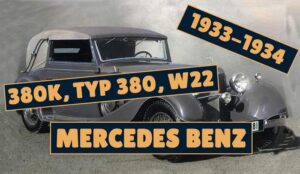If there was ever a competition of classic cars and you had to choose one which gave off a sense of consistent improvement to achieve the desired result, you’d be wrong not to choose the Mercedes-Benz W03, and just hold on to your horses because I’ll tell you why.
The Mercedes-Benz W03 was a massive six-cylinder-engine car presented as the Mercedes-Benz 12/55 PS by Daimler-Benz at the Berlin Motor Show in October 1926. Prior to this, it was widely known as the Mercedes-Benz Typ 300. The development of this classic was fast-tracked by Technical Director Ferdinand Porsche in light of the Daimler/Benz merger.
The manufacturer applied the German naming conventions, which was common. 12 specified the car tax horsepower, which was used by the authorities to calculate the amount of annual car tax to be levied on car owners. 55 specified the statements of the manufacturer regarding the actual power output of the car as defined in Horsepower.
The model was updated in 1927 and efficiently re-launched in 1929, gaining a lot of attention from the new Technical Director, Hans Nibel.
This classic boasts of as many as four different models, each having their peculiarities and a few similarities. Let’s have a sneak peek at them, shall we?
Mercedes-Benz Typ 300 (W03, 1926–1927)
This model packed a maximum output of 55 PS at 3,500 rpm, which was provided by the side-valve six-cylinder 2,968 cc engine, which resulted in a top speed of 100 km/h. The transfer of power was via a four-speed manual transmission to the rear wheels. Braking was applied to all four wheels, which were mechanically operated by rod connections. With just 205 cars sold in 1926, the W03 struggled to find as many clients as the manufacturer had hoped, and although the W03 was very comfortable, it was seen as too big and heavy. Perhaps people just saw it as the big lady.
Mercedes-Benz Typ 300 (W 04, 1927–1928)
A new model number W04, was involved in the update in early 1927, and although the transmission system was unchanged, the dimensions of the cylinder were slightly altered, resulting in an increase to 2,994 cc in total engine capacity at 55 hp, but at a lower engine speed of 3,200 rpm as the claimed maximum output was unchanged.
This model performed better in the market as sales levels increased, but the volumes continued to be far-off from what was expected by the manufacturer, and the W04 was destined to receive another tuning in 1928.
Mercedes-Benz Typ 320 (W 04, 1928)
After increasing the final drive, and the maximum speed for 1927, the manufacturers then moved to provide a choice of ratios, either lowering it down to 5.4:1 or improving it to 5.8:1. At the same time, an improvement in total engine power to 3,131 CC was accounted for by a slight increase in the cylinder stroke. At 55 PS, the claimed maximum output was unchanged, still at 3,200 RPM.
Mercedes-Benz Typ 350 (W 05, 1929–1930)
The engine was further extended to 3.444 cc, and for the first time with this model, there was also an improvement in the stated maximum power, now at 60 hp (44 kW; 59 hp), still at 3.200. Gearbox ratios remained unchanged again, but the rear axle ratio was then reduced to 5.0:1 or 5.4:1, accounting for a top speed of 103 km/h (64 mph) and 100 km/h (62 mph), respectively.
People connect to cars in different ways, but one thing this classic tells us is that no matter what, you just need to keep on trying until you get it right.
That’s all folks, if you have enjoyed the video, it’ll be greatly appreciated if you smash that like button, and stay tuned for another classic car video.

![You are currently viewing Mercedes-Benz W03 – [Typ 12/55 PS / Typ 300] – (1926 – 1930)](https://classicsdude.com/wp-content/uploads/2021/05/W03-website.jpg)


